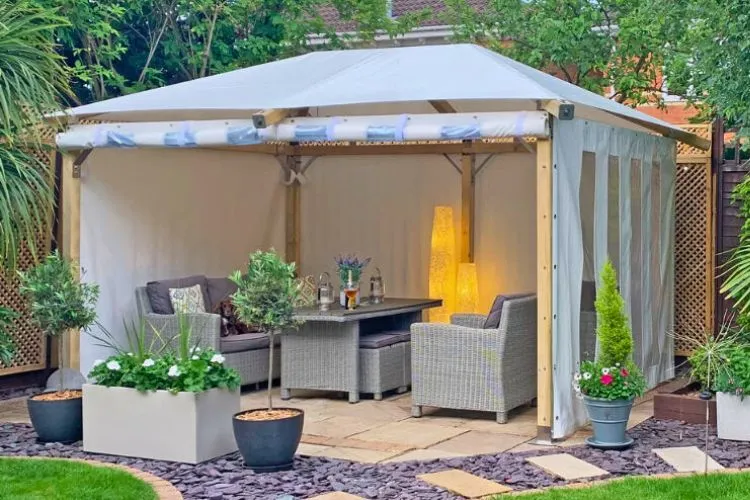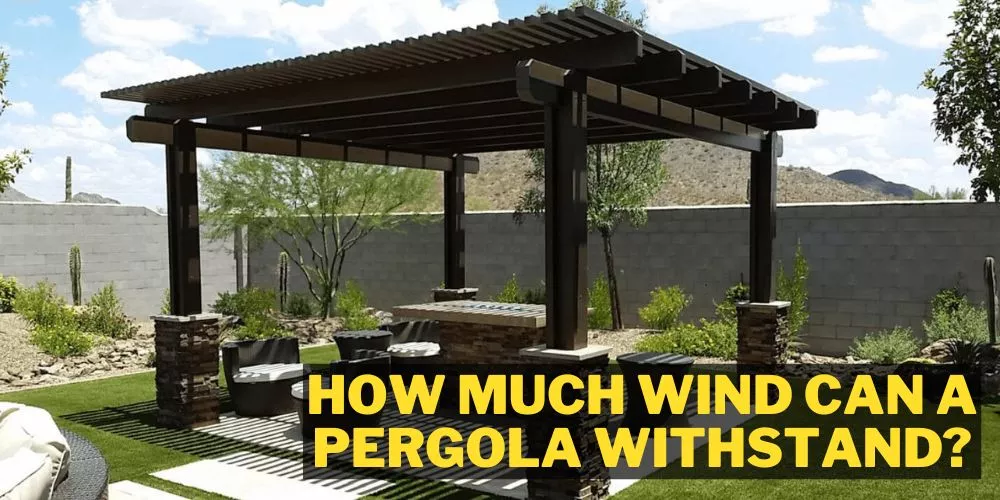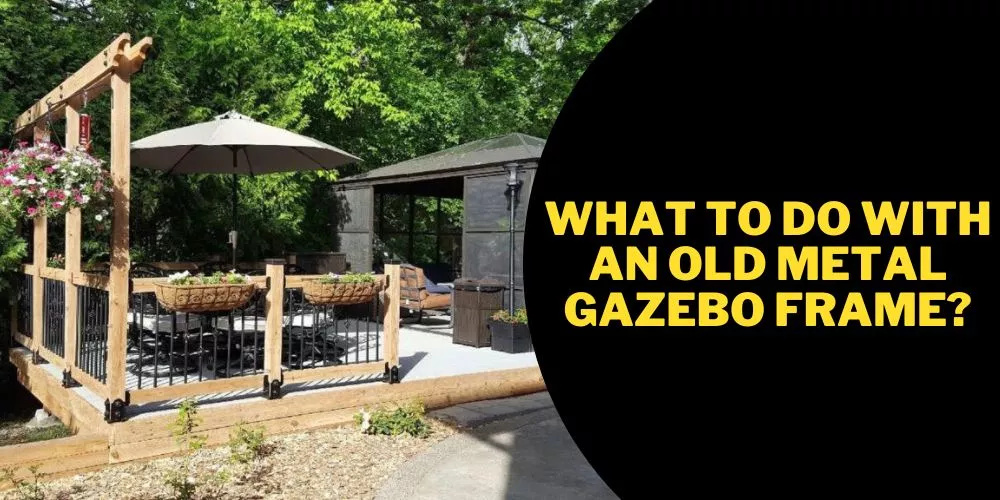Ever set up a gazebo for a peaceful afternoon, only to have the tranquility shattered by its sides incessantly flapping in the wind? We feel your frustration. It’s a common issue that many gazebo owners grapple with, often turning relaxing moments into bouts of annoyance.
But beyond the mere disturbance, there’s a bigger concern: the constant flapping can wear out the material, compromising your gazebo’s durability.
This article delves deep into the root causes of this problem and offers actionable solutions for how to stop gazebo sides flapping. By addressing the flapping, you will enhance the comfort of your outdoor experience and significantly extend the lifespan of your gazebo. So, if you’re eager to transform your windy woes into serene relaxation, read on!

Understanding the Causes of Gazebo Sides Flapping
The serene ambiance of a gazebo can quickly be disturbed by the constant flapping of its sides. But what causes this unwelcome interruption? Let’s dive into the primary culprits.
- Wind Direction and Speed: Undeniably, the wind plays the leading role in this act. The direction from which the wind blows can exert pressure on specific sides of the gazebo, causing them to flap. For instance, if the gazebo is directly in the path of prevailing winds, the sides facing the wind will naturally be more susceptible. Additionally, the faster the wind speed, the more force it exerts, leading to increased flapping, especially during gusty conditions.
- Lightweight Materials: The type of material your gazebo is made from can significantly influence its behavior in the wind. Lightweight fabrics, while easy to set up and move, can act like a sail on a boat, catching the wind and billowing. This billowing effect can intensify the flapping, making it more pronounced than heavier materials.
- Gazebo Design and Location: The design of your gazebo matters. Open-sided designs can allow more wind to pass, sometimes exacerbating flapping. On the other hand, gazebos with sides that are more enclosed can provide a buffer against the wind. Additionally, where you place your gazebo is crucial. A gazebo atop a hill or in an open field might bear the full brunt of the wind, whereas one nestled between trees or structures could be shielded from its force.
How to Stop Gazebo Sides Flapping?
Whether it’s choosing the perfect spot, reinforcing the design, or adding just the right accessories, we’ll walk you through every step. So, let’s embark on this journey to ensure your gazebo remains steadfast and serene, even when the wind decides to play its tricks.
1. Assessing Your Gazebo Site
Before erecting your gazebo, some groundwork can save you from a great deal of hassle later. The location of your gazebo plays a paramount role in determining how much it will be affected by the wind. A strategic assessment can be the key to a serene and stable gazebo experience.

- Choosing an Optimal Location: It’s not just about where the view is best but also where the wind is least troublesome. Prevailing winds, the dominant wind direction for a particular region, can be a gazebo’s constant adversary. By understanding the primary wind direction in your area, you can position your gazebo so that the sides are less exposed to these prevailing winds. Remember, it’s not just about avoiding the wind but strategically positioning your gazebo so it’s shielded from its strongest forces.
- Using Natural Barriers: Mother Nature provides some of the best windbreaks. Trees, especially those with dense foliage, can act as natural shields, breaking the wind’s force before it reaches your gazebo. If trees aren’t an option, consider leveraging existing structures. Placing your gazebo near buildings, tall fences, or hedges can significantly reduce wind exposure. Not only do these barriers protect against the wind, but they can also add an element of privacy and coziness to your gazebo setting.
2. Selecting the Right Gazebo Design and Material
Once you’ve picked an optimal site, the design and material of your gazebo come into play. Just as a ship’s design determines how it fares in turbulent waters, the structure and fabric of your gazebo can greatly influence its behavior in the wind.
- Opt for Sturdy Materials: While lightweight materials might be appealing for their portability and ease of setup, they can be more susceptible to the whims of the wind. Opting for a gazebo made of sturdier, more robust fabric or material can offer more resistance to flapping. For instance, canvases or polyester materials reinforced with PVC can offer a good balance of durability and wind resistance.
- Consider Closed or Semi-Closed Designs: Open-sided gazebos provide panoramic views but can also invite more wind interference. A gazebo with a closed or semi-closed design can act as a buffer, reducing the wind’s entry points. Furthermore, designs with adjustable side panels offer flexibility; you can open them up on calm days and close them when it gets gusty.
- Reinforcing the Structure for Added Stability: Additional supports, such as cross-bracing or reinforced poles, can enhance your gazebo’s structural integrity. A more robust frame can reduce the chances of the entire gazebo swaying in the wind, diminishing its sides’ flapping.
3. Attaching Gazebo Sides Properly
Even with the most strategic location and optimal design, attaching your gazebo’s sides can make or break its stability in the wind. Proper attachment not only prevents the sides from flapping but also extends the life of your gazebo by reducing wear and tear.
- Ensuring Secure Attachment of Gazebo Walls: The edges of your gazebo walls are the prime spots where wind can find its way in. Ensure they’re anchored securely. If your gazebo has built-in loops or eyelets, make use of them! Tie them down to the frame or ground pegs, reducing any loose or slack areas that wind can exploit.
- Using Heavy-Duty Zippers, Ties, or Fasteners: While standard fasteners might do the job on calm days, they may falter in stronger gusts. Investing in heavy-duty zippers or ties can make a world of difference. Velcro, while convenient, can sometimes come apart in strong winds, so complement them with ties or clips for added security.
- Regularly Checking and Tightening Connections: Wind can cause fastenings to loosen over time. Make it a habit to inspect your gazebo’s attachments, especially after windy days. Tighten loose connections, and replace worn-out or frayed ties to ensure continuous stability.
4. Using Wind-Resistant Gazebo Accessories
Your gazebo is more than just a structure; it’s a space that can be personalized and enhanced with the right accessories. When wind becomes a concern, choosing accessories that beautify and bolster your gazebo’s resilience can make all the difference.

- Windproof Curtains with Tie-Downs or Weights: Standard curtains can flap wildly in the wind, but windproof ones are designed to stay put. These are often made of thicker materials and come with built-in tie-downs or pockets at the bottom where weights can be added. These weights ensure the curtains hang straight down, reducing the chances of them billowing out.
- Solid Panels Instead of Mesh for Wind Blocking: Mesh panels provide good ventilation, sometimes allowing wind to seep through. Switching to solid panels can act as an effective barrier against the wind. They’re especially beneficial in areas prone to constant breezes or gusty conditions.
- Investing in Windbreakers or Screens for Added Protection: Windbreakers are panels or screens designed to block or redirect wind. Placing them around the perimeter of your gazebo can shield the interior from the brunt of the wind. They can be particularly helpful if your gazebo is in an open area with few natural barriers.
5. DIY Solutions to Prevent Gazebo Sides Flapping
For the hands-on individuals among us, there’s a unique satisfaction in using a bit of DIY ingenuity to tackle challenges. Flapping gazebo sides? There’s a DIY solution for that. These simple yet effective hacks can make a noticeable difference, turning a flimsy gazebo side into a steadfast wall.
- Adding Extra Hooks or Grommets for Tie-Downs: Sometimes, the manufacturer’s provisions for tying down your gazebo sides aren’t enough. Adding a few extra hooks or grommets, especially at the midpoint between existing ones, can reduce the span of unsupported material. This means fewer opportunities for the wind to get a good grip and cause a flap.
- Using Bungee Cords or Straps to Anchor Sides: Bungee cords are stretchy and resilient, providing a snug fit when used to anchor gazebo sides. You can keep the sides taut by attaching one end of the cord to the gazebo and the other to a ground stake or weight. Similarly, sturdy straps can pull the sides tight, minimizing any slack.
- Applying Adhesive Velcro Strips for Improved Sealing: Those tiny gaps between gazebo panels or at the corners can be wind magnets. You can seal these gaps effectively by strategically placing adhesive velcro strips along the edges. This prevents wind from sneaking in and helps maintain a consistent internal environment, be it warmth on a chilly day or coolness in the heat.
These DIY fixes, while simple, can be game-changers. With a little effort and some creativity, you can enhance your gazebo’s wind resistance, ensuring it remains a peaceful spot, no matter how the wind howls outside.
Pro Tips for Gazebo Maintenance and Longevity
Your gazebo is more than just a shelter; it’s a beloved gathering spot, an oasis of calm amidst nature. Like any prized possession, it deserves regular care to ensure its longevity. Here’s how you can give your gazebo the love it needs and keep it standing tall and proud for years.

- Regularly Inspecting and Tightening All Connections: With time and exposure to the elements, nuts, bolts, and fasteners can come loose. Make it a habit to walk around your gazebo, inspecting each connection point. A simple twist here or a tightening there can make a world of difference, ensuring your gazebo remains stable and safe.
- Storing Gazebo Sides When Not in Use: If you aren’t using your gazebo, consider storing its sides. Not only does this protect them from the unpredictabilities of the weather – be it harsh sun, rain, or wind – but it also extends their life by reducing continuous exposure and potential wear and tear.
- Applying Waterproofing Sprays to Increase Fabric Durability: Water can be a fabric’s worst enemy, leading to mold, mildew, or weakening over time. A good quality waterproofing spray can act as a shield, preventing water from soaking in and maintaining the fabric’s integrity and color.
Your gazebo’s lifespan isn’t just about its build or quality; it’s also about the care you shower upon it. With these pro tips, you can ensure that your gazebo doesn’t just last but thrives, offering you countless moments of serenity and joy.
Frequently Asked Questions (FAQs)
Why do gazebo sides flap more in certain weather conditions?
Gazebo sides flap due to wind dynamics. Sudden gusts, changing directions, or strong continuous winds exert pressure, causing lightweight materials to billow and flutter.
Can I use weights to prevent the gazebo sides from flapping?
Yes, weights anchor gazebo sides, providing stability and preventing them from lifting or flapping in breezy conditions.
Are there specific materials that are better at reducing flapping?
Heavier, tightly-woven fabrics and materials, like canvas or polyester, reduce flapping due to their weight and reduced permeability to wind.
Can I make my wind-resistant gazebo sides?
Using heavy-duty materials, additional tie-downs, and weatherproofing treatments can help you craft wind-resistant gazebo sides.
Should I take down gazebo sides during extremely windy conditions?
Yes, removing sides in strong winds prevents damage, reduces stress on the frame, and ensures the structure’s and its users’ safety.
Conclusion:
In conclusion, ensuring your gazebo’s resistance to flapping involves multiple facets, from strategically selecting its location to carefully choosing materials and design. Equally crucial is the commitment to regular maintenance. Properly attached sides, reinforced by wind-resistant accessories, coupled with proactive measures like utilizing weights and waterproofing, can offer an unruffled experience.
The longevity and comfort of your gazebo largely depend on these considerations. We hope that this guide has been helpful in terms of learning how to stop gazebo sides flapping.


